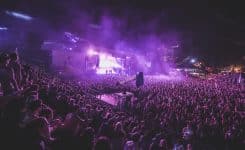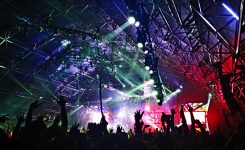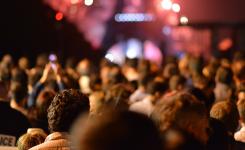Concerts, Live Events, Sponsors
Role of Social Media in Live Events
August 29, 2017 - Concerts, Live Events, Sponsors
In the times of the Roman Empire, gladiators fought beasts and the crowds waited for chariots to crash (like in NASCAR). We wouldn’t say that we share too many similarities today, however, a few things still ring true. One of which is promotions. Yes, you heard that right. During the days of the Coliseum, they didn’t have the internet (hard to imagine right?), they didn’t have flyers, nor did they have radio. But come the day of the event, the Coliseum filled with spectators—regardless of distance, crowds were there. It’s a chain of command, an influential voice that people listen to. It’s ideas/people/concepts that people need to witness—an experience that people can’t miss. All brought to you virally by social sharing. Today, the modern form leverages new tools. The contemporary form, Social Media, is just as influential. There’s a reason 98% of businesses use social media. However, successfully using social media can be a challenge. Part of that challenge is correctly leveraging the tools of the trade. It’s an integral part of business strategy, and is something companies need to get comfortable using. In live events, creating buzz is your business; attract the right people and manage the public’s expectations. Social media is a key ingredient in that process. Offering assistance from integrating sponsors to becoming an outlet for free advertising. With social media advancements like live streaming, it’s an inevitable part of a business’ future.
Use of Social Media #1 – Event Promotions
The most obvious is promotions. Getting the word out about your event is never easy, but social media is an easy cost effective way. Using at the bare minimum, Twitter, Facebook and Instagram, you have an opportunity to instantly connect and engage with thousands of potential customers. Create buzz by making your own hashtags and use online influencers and celebrity talent to double down on the engagement.Use of Social Media #2: Integrate Sponsors and Activations
Sponsors want the ability to advertise and you want a co-sign (and potentially some funding). Social media enhances the real-time engagement of attendees with sponsors. Social media posts amplifies the event, exponentially reaching every attendees’ network. Ultimately making it a must-see, must-attend event for the future. Bringing the sponsors name in tow, it strengthens the sponsors name making it a great tool for activation as well. Organic and subtle is key though, as intrusive marketing makes it too obvious and alienating to the target market. Social media is the perfect vehicle for this type of value-driven content, providing potential customers the opportunity to interact with your event and your sponsor’s’ product, all while generating real value for themselves.Reason #3: Ticket Sales Integration
Social Media—it’s a news source, it’s a way for a person to share with their network and for their network to listen to their ‘reliable’ source. It only makes sense that integrating sales, like tickets sales, is the natural evolution. If you knew your friends were going to an event, you’d naturally be more inclined to buying tickets. By integrating the platform directly into a source like Facebook or a WeChat, sales conversions dramatically increase.Reason #4: Data Collection
Simply put, Big Brother is omniscient online. Always there, always knowing. By integrating social media, you’ve put the data out there that you can control and collect. Social media-derived data, is far more amenable to analysis than the traditional media data you get from surveys and raw sales data. You’re able to instantly see which forms of marketing work and which don’t by simply tracking engagement through social media analytics. Simply using Google Analytics right out of the box, you can already break down geographical data, time of date and pages a consumer visits. Data is key to knowing your consumer and how to serve them better.Reason #5: Emergency Services
In my opinion, this is a necessity. When large groups gather, risks of injury, brawls and emergencies rise. Going through traditional channels to convey valuable safety information to your attendees is still needed (public announcements, radio, 9-1-1). However, the easiest way to efficiently disseminate information quickly is through social media.The Federal Emergency Management Agency (FEMA) wrote in its 2013 National Preparedness report that during and immediately following Hurricane Sandy, “users sent more than 20 million Sandy-related Twitter posts, or “tweets,” despite the loss of cell phone service during the peak of the storm.” – Scientific AmericanIn terrorism disasters like the Manchester bombing after the Ariana Grande concert a few months ago, social media was used. Emergency services used it to locate the injured. News companies used it to convey messages and news to the public. The attendees of the concert used it to find out what was happening and what to do. And the public used social media as a way to offer help to those that were affected. Since nearly everyone has smartphones, the use of social media can be a life saver. By using social media and integrating it properly within your network, you’ll be able to increase sales, track data and ultimately help in running a safe event.








